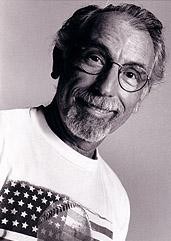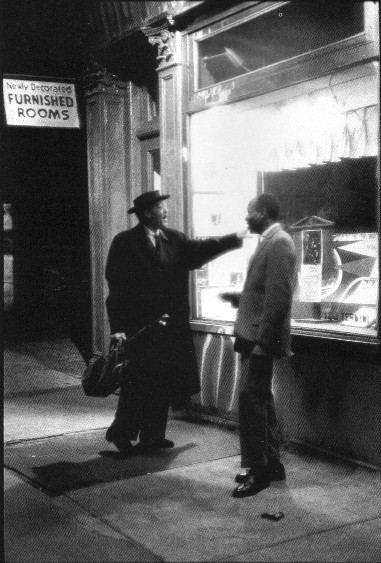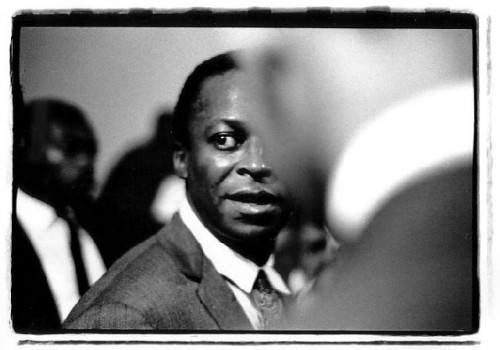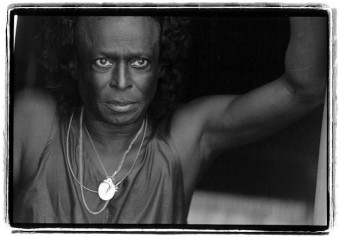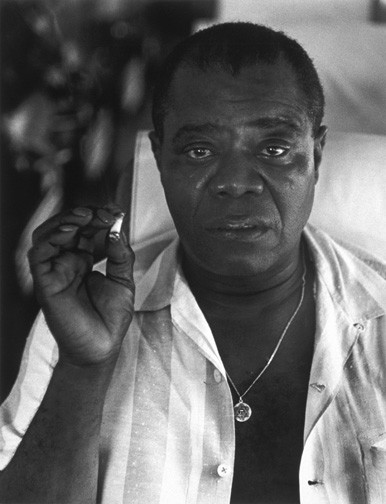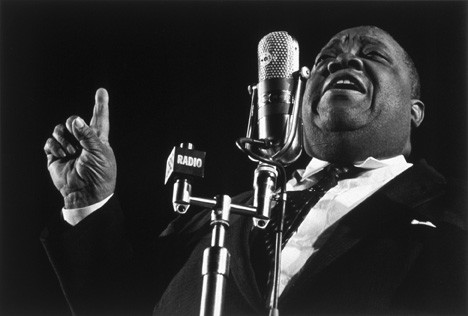Herb Snitzer at Gallery Kayafas
Celebrating Jazz in a Book and Exhibition
By: Charles Giuliano - Dec 30, 2010
Charles Giuliano We met some years ago at Sandy’s Jazz Revival when the Woody Herman Band was performing. After that we ran into each other now and then at jazz events. After losing contact we reconnected by e mail. You have relocated to Florida.
You are returning to Boston for an exhibition at Gallery Kayafas and a book event. Can you update us and discuss how you came to photograph jazz as a subject. Did you have a formal education in photography? How did this lead to music as a field.
Herb Snitzer Glorious Days and Nights: A Jazz Memoir is the title of the book, which is more than jazz images but rather a memoir of my time living and working in New York and then Boston/Cambridge area. There are 85 jazz images but it is important to know that Jazz is one aspect of my over 50 years career, albeit a very important part of my career.
I was the former photography and then associate editor of the jazz magazine, Metronome The editor, Dan Morgenstern and I were the last two editors of the magazine. It went out of business at the end of 1961, a long time ago. Dan has written an afterward to my book, we are still alive and he is the Director of Jazz Studies at Rutgers University.
My exhibition at the Gallery Kayafas will run from January 21 to February 26, with a reception and book signing on Feb 4, 6 - 8pm. Arlette Kayafas is my contact person there. The majority of the images which will be shown are also in the book. She is making the choices for the exhibition.
I have been writing my memoirs for a number of years and was able to find the University Press of Mississippi, a press that has been influential in publishing books on music. They have been very supportive of this project. I have already published a number of other books over the years and I think my web site lists them: www.herbsnitzer.com
I do have a jazz book, locally published: JAZZ, A Visual Journey. 1999.
I graduated from The Philadelphia College of Art in 1957, and immediately moved to New York City. I majored in photography and my senior thesis was an extended exploration of The Philadelphia Orchestra. I have always been involved with music so it was a natural thing to see if I could meld photography with music, which I was very able to do within the jazz world but I also photographed many classical folks: John Cage, Leonard Bernstein, Otto Klemperer, Christopher Hogwood, Boston Camerata, along with other well known people such as Tennessee Williams, Bette Davis, Patrick O'Neill, and on and on. It was an exciting time in my life both in New York and elsewhere.
One of the last couple of times I was immersed with jazz was during the period, 1986 to 1989, when I went to Bern, Switzerland four consecutive years to cover the Bern Intl Jazz Festival, all coming about because of a small tour I took with Nina Simone, one of my very good friends for many years. We went to Bern in December, 1986 at which time I saw the wonderful jazz drumer, Oliver Jackson who introduced me to the producer of the Festival and Hans Zurbrugg brought me back three years in a row to cover the Festival and it was a wonderful opportunity to meet old friends and to make new friends within the jazz community.
I continue to photograph jazz folks when they come to St. Petersburg, or Tampa. Recently photographed Jonathan Powell and the trombonist, Vincent Gardner (he is in the Lincoln Center Jazz Orchestra). I continue to shoot with film. I have no digital equipment and plan not to buy any in the near future. I make silver gelatin prints (do all my own printing) and show in other galleries around the country. I feel blessed.
CG Why are you still doing darkroom printing when it is so much easier and faster with digital printing?
HS My reputation is with silver gelatin prints and I am content in making and selling these images. I am not so concerned with speed, therefore ease and quickness in making images is not my primary concern. I also prefer the quality of the silver based finish than ink on paper.
CG When you started photographing jazz artists were you looking at other "vintage" (?) photographers?
HS When I first started working as a photographer I was very impressed by W. Eugene Smith, Robert Capa, Edward Weston, Aaron Siskind (who eventually became a mentor) Edward Steichen, Dorothea Lang, Werner Bischoff, etc. Farm Security photographers of the ‘30s and ‘40s as well.
CG What were some of the limits of the subject matter? Shooting performers moving about? Did you have access off stage?
HS Yes, the jazz clubs were dark, but the stage was lit up. My main concern was photographing black artists. Black skin was not as reflective as white skin so I had to always be aware of my f-stops (lens opening). Whenever I photographed I had complete access to back stage (Lester Young, Nina Simone, John Coltrane, Miles Davis, Sarah Vaughan, Joe Williams, on and on). Ditto when I was at record sessions - could roam about as I needed to.
CG Did you work with writers covering assignments?
HS Yes and No. At times I was on my own and there were times when a magazine writer was with me. I certainly collaborated well but the majority of time I was on my own. When I photographed for LIFE I was always with a writer, not so for the less popular magazines.
CG You state that music is just an aspect of your work. But it is what you are best known for.
HS Yes, it is true that my modest reputation is within the world of music, classical as well as jazz but I have been photographing for over 50 years and many, many images that I think are important images have nothing to do with jazz; they have to do with similar characteristics and concerns. Jazz is a metaphor for freedom, but I have also made images directly relating to social/ political protests and concerns. One of my favorite image is of a young Nazi with hateful tattoos on his arms and neck, giving me the finger as I approached him. Nina Simone would of be proud! (She was a close and dear friend).
CG When it comes to editing a book there is the difference between great image of a lesser known artist or a lesser image of a great performer? How do you make a decision in that regard?
HS The combination of a great image of a great artist has always been primary in my mind. I have a number of iconic images of great jazz performers. I feel blessed but if I had to choose, I would take a great image of a lesser known artist. Ditto any social/political image as well. The emotional impact is primary.
CG Can you give us some sense of the extent of the archive? When does it begin? Approximately how many performers are covered? When you were in New York (dates) what were you shooting? Clubs? Concerts? Recording sessions?
HS My archives are extensive, covering over 700,000 negatives and color 'chromes covering over 50 years of making images. My first serious photographs were made when I was in the US Army during the Korean War years (1953 to 1955 was my tour of duty).
I returned to the Philadelphia College of Art, finished my last two years and moved to New York in June, 1957.
I considered myself to be part of the "street photographer's esthetic" walking the streets of New York, reflecting on the growth of the city, its contradictions, its wonderful cultural institutions. I began to explore employment opportunities using my photographic background. I decided to go to the record companies as a beginning exploration. I also went to magazines, newspapers, as well as a few of the museums that considered photography as art. I needed to make a living.
One thing leads to another and I was directed to a jazz magazine called "Metronome." I was asked to photograph Lester Young, a jazz saxophonist, at The Five Spot Cafe in the Bowery. My life dramatically changed with this assignment. Although I continued to seek out photographic assignments, I began to concentrate on making jazz images. I was also making a year long study of Central Park which through good fortune was exhibited at The Museum of The City of New York in 1959. This show was extensively covered by The New York Herald Tribune, and many other publications (hard to remember after all these years).
I met and photographed Nina Simone for Colpix Records (her first two records for Colpix) and she and I became lifelong friends. She was a wonderful artist and caring human being, warts and all, because she was also difficult to get along but somehow we overcame all the difficulties that friends have. I loved her and I miss her! I began to photograph jazz artists in all their venues: concerts, clubs, recording sessions, at home on the road, etc. It was a great seven years (1957 to 1964).
CG How and when did you move to Boston? Was it because of a teaching gig? What were you shooting in Boston?
HS I moved to Cambridge, MA in 1978, taking a position with the Polaroid Education Project and at that point I slowly became part of the photographic community in Boston and also started to part-time teach at The Art Institute of Boston. I also joined the Board of The Boston Camerata. I made hundreds if not thousands of images of the Boston Camerata, as well as covering some of the local jazz folks. My focus was on the education project. I was able to meet and photograph many New York jazz musicians who came to Harvard to play with the Harvard Jazz Band. The jazz saxophonist Joshua Redman was in the band as was the son of John Lewis of The Modern Jazz Quartet. I asked this young man (sorry, his name escapes me) if music was going to be his next step and he responded, "Oh no, I'm an economist." Harvard drew many well known musicians - Gerri Mulligan, Lester Bowie, Betty Carter, Benny Carter. I also met and photographed Abbey Lincoln, Randy Weston, Joe Williams, Zoot Sims, Al Cohn, Ernestine Anderson, Jimmy Heath.
CG When and why did you move to Florida? How has that changed your practice? Are you primarily involved with the vintage material?
HS I moved to Florida in January 1992. Many personal issues determined this move and I would prefer we not explore these issues. I live in St. Petersburg, and it is far from a jazz center. There are a few wonderful players in Tampa/St. Petersburg and a terrific DJ, Bob Seymour, on USF Radio. He really knows his subjects and plays all the great "mainstream" artists. Yes, I guess my main interest now is to get my work out into the "marketplace" more and more, and the response has been terrific. Collectors are paying attention and I am sure my new book coming out in January will help a great deal. I continue to show my work in selected galleries around the country, which has been a blessing.
CG What are your current projects? How difficult is it to publish and sell the jazz material? How do you make photo editors aware of the material? As I discussed with you before transferring/scanning negatives/slides to digital would make the archive far more accessible. Particularly in tweaking color images for print publication.
HS I photograph local events; Gay Pride Parade, Social protests, and for the past four years I went to Fort Benning, GA to protest the School of The Americas and these images are strong and emotionally powerful - or so I believe. Interestingly I had the opportunity to meet the actors Martin Sheen and Susan Sarandon at the GA protests. Of course I made a few images of both.
I am slowly scanning many of my 8 x 10 press prints but have not done anything with the color 'chromes. In time these too will be scanned. I am actually not in a hurry to do so. As far as getting editors to know of my archive, yes I do this and many of the national newspapers and magazines do know of my jazz archive. I am also represented by Getty Images and they get my work published throughout the world. The number of jazz writers and institutions are also aware of my work. Like any other family, jazz folks know of each other (for better or worse)
CG You mention being close to Nina Simone. Can you tell more about that relationship. Were there other performers you were particularly close to?
HS Trumpet player Clark Terry, the late saxophonist Al Cohn, the singer Sheila Jordan, trombonist Trummy Young. There were others I could hang out with such as Oliver Jackson, Abbey Lincoln, Jimmy Guiiffre, bassist Milt Hinton, Jimmy Heath and pianist, Michel Camilo.
CG Of the images in the book/exhibition are there ones that you find to be particularly meaningful to you? As images or perhaps to recall specific experiences? Basically what makes an iconic image?
HS The exhibition was put together by Arlette Kayafas, the gallery owner, choosing the images from about 75 that I sent her, so your guess is as good as mine as to what is in the gallery. I am looking forward to seeing the work mounted and framed. I do know she used the wonderful image of Dizzy Gillespie, trumpet thrust upward on the right side of the image, cheeks puffed, pinkie ring in the forefront.
This image has lasted all these years, which relates to your question about what makes an image iconic? There are millions of pictures made every year, very few photographs, and those photographs which last, never seem to get "tired," are those images which are categorized as "iconic." I have been blessed, over the years to have made a few: Louis Armstrong with Star of David on his chest, Lester Young in front of The Five Spot, John Coltrane reflected in a mirror, backstage at The Village Gate, Nina Simone, laughing, head back seated on a stool, Thelonious Monk, piano keys reflected in his sun glasses (many, many other photographers have now used this image to make their own "reflected glasses image). There are many more.

